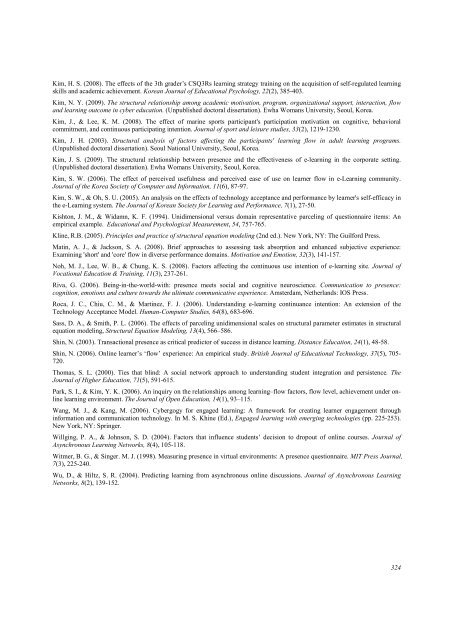Download Complete Issue in PDF - Educational Technology & Society
Download Complete Issue in PDF - Educational Technology & Society
Download Complete Issue in PDF - Educational Technology & Society
You also want an ePaper? Increase the reach of your titles
YUMPU automatically turns print PDFs into web optimized ePapers that Google loves.
Kim, H. S. (2008). The effects of the 3th grader’s CSQ3Rs learn<strong>in</strong>g strategy tra<strong>in</strong><strong>in</strong>g on the acquisition of self-regulated learn<strong>in</strong>g<br />
skills and academic achievement. Korean Journal of <strong>Educational</strong> Psychology, 22(2), 385-403.<br />
Kim, N. Y. (2009). The structural relationship among academic motivation, program, organizational support, <strong>in</strong>teraction, flow<br />
and learn<strong>in</strong>g outcome <strong>in</strong> cyber education. (Unpublished doctoral dissertation). Ewha Womans University, Seoul, Korea.<br />
Kim, J., & Lee, K. M. (2008). The effect of mar<strong>in</strong>e sports participant's participation motivation on cognitive, behavioral<br />
commitment, and cont<strong>in</strong>uous participat<strong>in</strong>g <strong>in</strong>tention. Journal of sport and leisure studies, 33(2), 1219-1230.<br />
Kim, J. H. (2003). Structural analysis of factors affect<strong>in</strong>g the participants' learn<strong>in</strong>g flow <strong>in</strong> adult learn<strong>in</strong>g programs.<br />
(Unpublished doctoral dissertation). Seoul National University, Seoul, Korea.<br />
Kim, J. S. (2009). The structural relationship between presence and the effectiveness of e-learn<strong>in</strong>g <strong>in</strong> the corporate sett<strong>in</strong>g.<br />
(Unpublished doctoral dissertation). Ewha Womans University, Seoul, Korea.<br />
Kim, S. W. (2006). The effect of perceived usefulness and perceived ease of use on learner flow <strong>in</strong> e-Learn<strong>in</strong>g community.<br />
Journal of the Korea <strong>Society</strong> of Computer and Information, 11(6), 87-97.<br />
Kim, S. W., & Oh, S. U. (2005). An analysis on the effects of technology acceptance and performance by learner's self-efficacy <strong>in</strong><br />
the e-Learn<strong>in</strong>g system. The Journal of Korean <strong>Society</strong> for Learn<strong>in</strong>g and Performance, 7(1), 27-50.<br />
Kishton, J. M., & Widamn, K. F. (1994). Unidimensional versus doma<strong>in</strong> representative parcel<strong>in</strong>g of questionnaire items: An<br />
empirical example. <strong>Educational</strong> and Psychological Measurement, 54, 757-765.<br />
Kl<strong>in</strong>e, R.B. (2005). Pr<strong>in</strong>ciples and practice of structural equation model<strong>in</strong>g (2nd ed.). New York, NY: The Guilford Press.<br />
Mat<strong>in</strong>, A. J., & Jackson, S. A. (2008). Brief approaches to assess<strong>in</strong>g task absorption and enhanced subjective experience:<br />
Exam<strong>in</strong><strong>in</strong>g 'short' and 'core' flow <strong>in</strong> diverse performance doma<strong>in</strong>s. Motivation and Emotion, 32(3), 141-157.<br />
Noh, M. J., Lee, W. B., & Chung, K. S. (2008). Factors affect<strong>in</strong>g the cont<strong>in</strong>uous use <strong>in</strong>tention of e-learn<strong>in</strong>g site. Journal of<br />
Vocational Education & Tra<strong>in</strong><strong>in</strong>g, 11(3), 237-261.<br />
Riva, G. (2006). Be<strong>in</strong>g-<strong>in</strong>-the-world-with: presence meets social and cognitive neuroscience. Communication to presence:<br />
cognition, emotions and culture towards the ultimate communicative experience. Amsterdam, Netherlands: IOS Press.<br />
Roca, J. C., Chiu, C. M., & Mart<strong>in</strong>ez, F. J. (2006). Understand<strong>in</strong>g e-learn<strong>in</strong>g cont<strong>in</strong>uance <strong>in</strong>tention: An extension of the<br />
<strong>Technology</strong> Acceptance Model. Human-Computer Studies, 64(8), 683-696.<br />
Sass, D. A., & Smith, P. L. (2006). The effects of parcel<strong>in</strong>g unidimensional scales on structural parameter estimates <strong>in</strong> structural<br />
equation model<strong>in</strong>g, Structural Equation Model<strong>in</strong>g, 13(4), 566–586.<br />
Sh<strong>in</strong>, N. (2003). Transactional presence as critical predictor of success <strong>in</strong> distance learn<strong>in</strong>g. Distance Education, 24(1), 48-58.<br />
Sh<strong>in</strong>, N. (2006). Onl<strong>in</strong>e learner’s ‘flow’ experience: An empirical study. British Journal of <strong>Educational</strong> <strong>Technology</strong>, 37(5), 705-<br />
720.<br />
Thomas, S. L. (2000). Ties that bl<strong>in</strong>d: A social network approach to understand<strong>in</strong>g student <strong>in</strong>tegration and persistence. The<br />
Journal of Higher Education, 71(5), 591-615.<br />
Park, S. I., & Kim, Y. K. (2006). An <strong>in</strong>quiry on the relationships among learn<strong>in</strong>g–flow factors, flow level, achievement under onl<strong>in</strong>e<br />
learn<strong>in</strong>g environment. The Journal of Open Education, 14(1), 93–115.<br />
Wang, M. J., & Kang, M. (2006). Cybergogy for engaged learn<strong>in</strong>g: A framework for creat<strong>in</strong>g learner engagement through<br />
<strong>in</strong>formation and communication technology. In M. S. Kh<strong>in</strong>e (Ed.), Engaged learn<strong>in</strong>g with emerg<strong>in</strong>g technologies (pp. 225-253).<br />
New York, NY: Spr<strong>in</strong>ger.<br />
Willg<strong>in</strong>g, P. A., & Johnson, S. D. (2004). Factors that <strong>in</strong>fluence students’ decision to dropout of onl<strong>in</strong>e courses. Journal of<br />
Asynchronous Learn<strong>in</strong>g Networks, 8(4), 105-118.<br />
Witmer, B. G., & S<strong>in</strong>ger. M. J. (1998). Measur<strong>in</strong>g presence <strong>in</strong> virtual environments: A presence questionnaire. MIT Press Journal,<br />
7(3), 225-240.<br />
Wu, D., & Hiltz, S. R. (2004). Predict<strong>in</strong>g learn<strong>in</strong>g from asynchronous onl<strong>in</strong>e discussions. Journal of Asynchronous Learn<strong>in</strong>g<br />
Networks, 8(2), 139-152.<br />
324

















